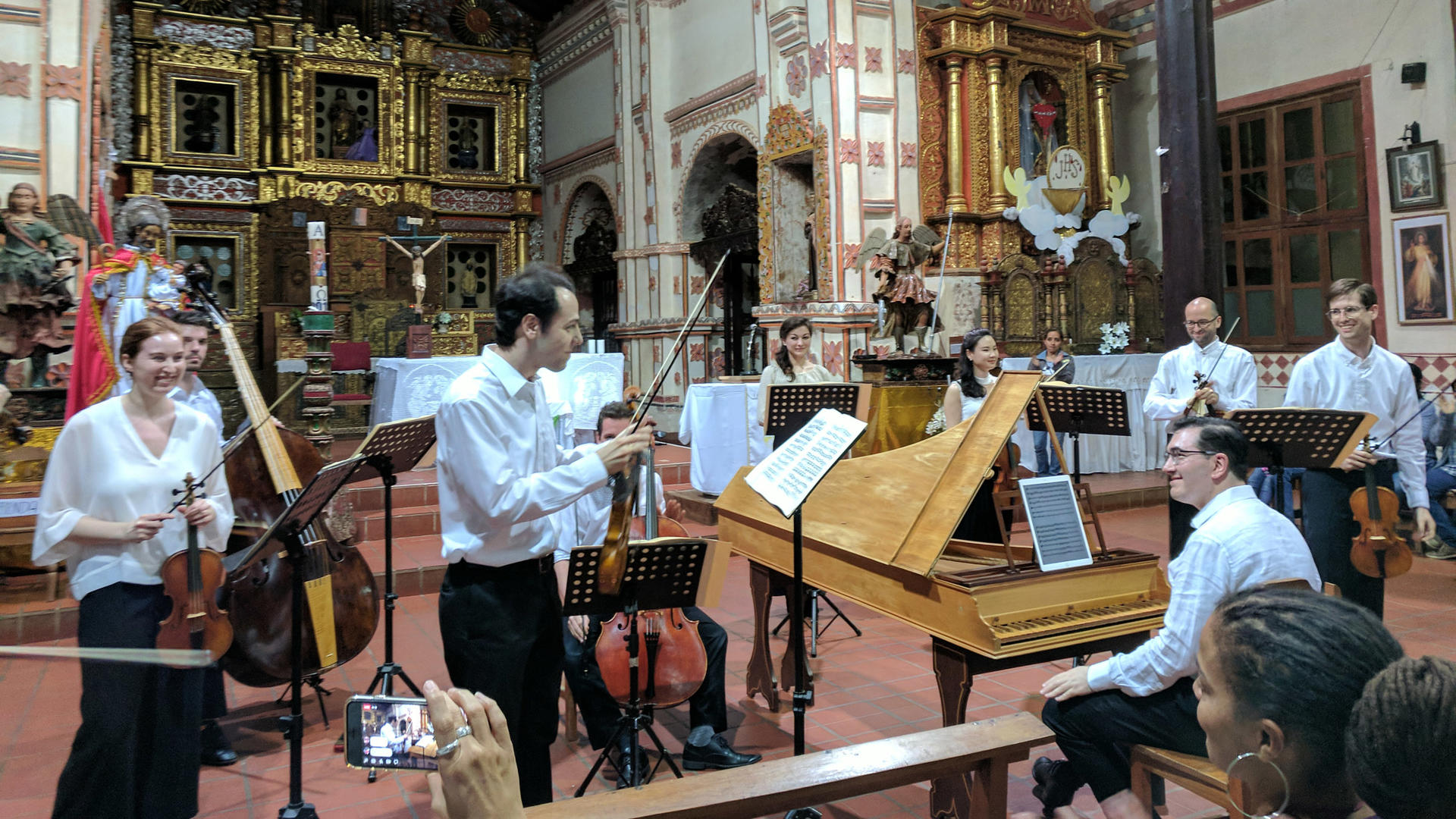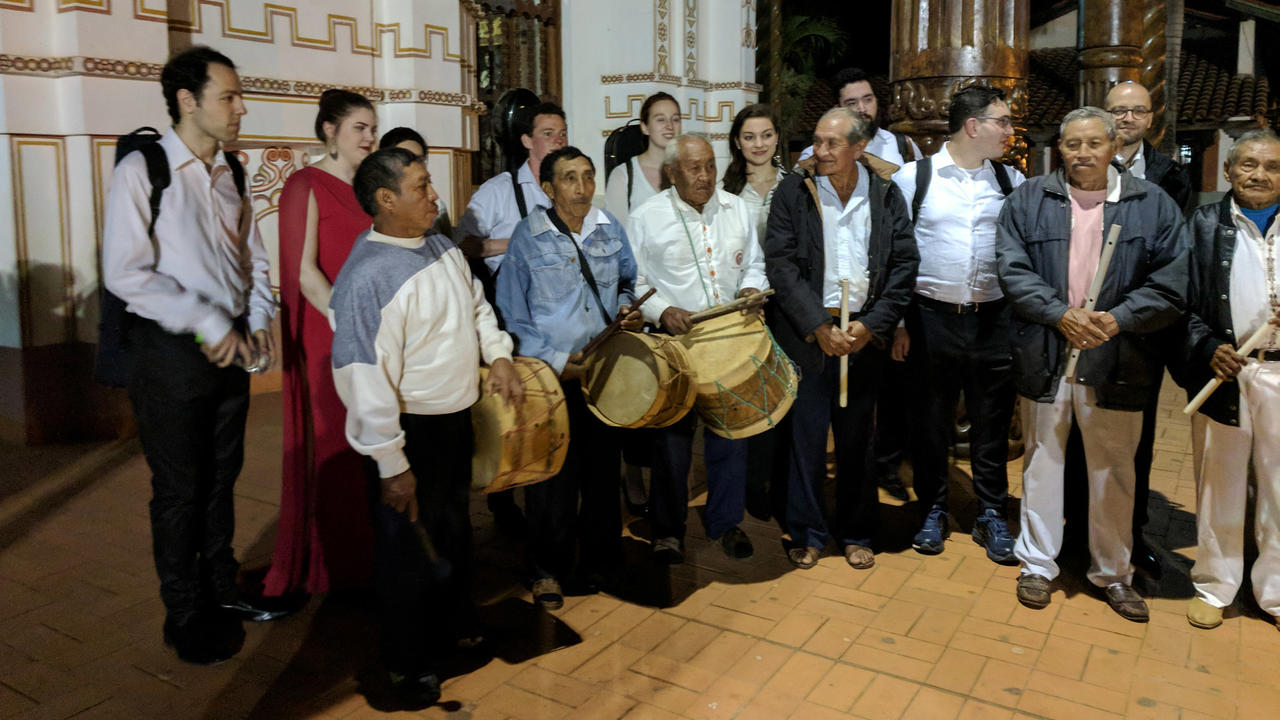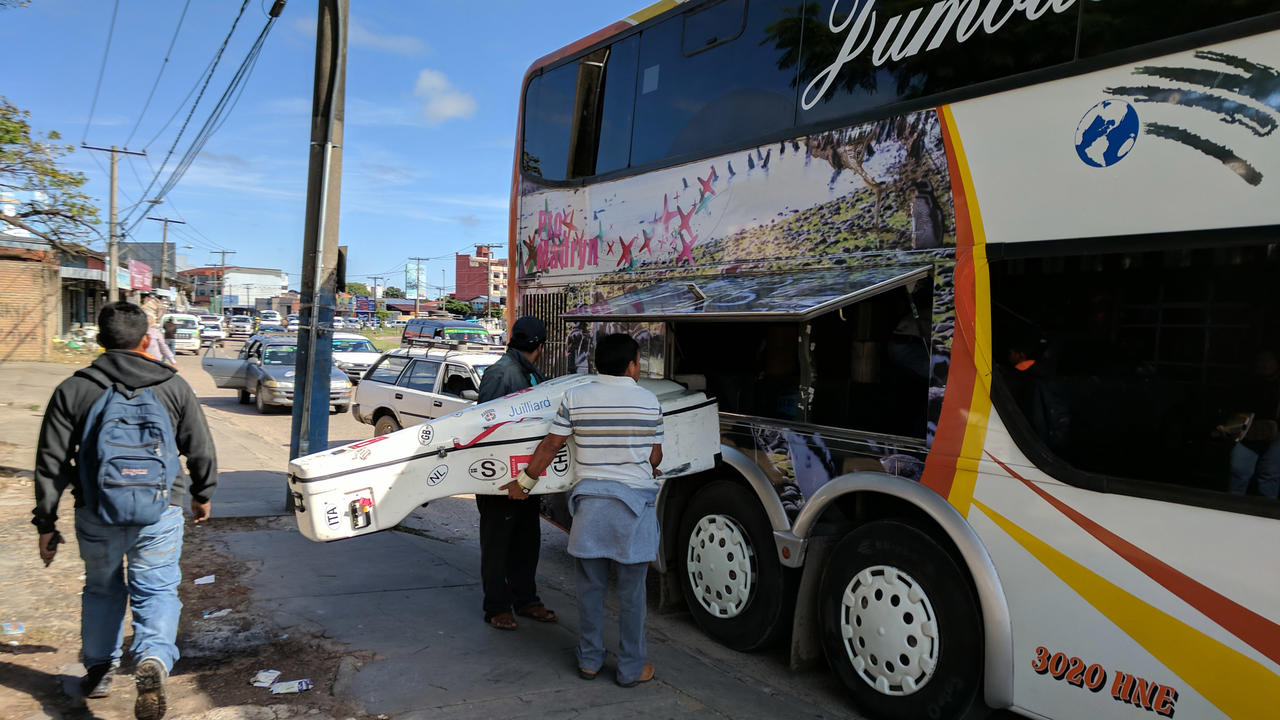
This spring an alumni edition of Historical Performance’s Juilliard415 ensemble (students couldn’t go because they would have missed classes) accepted a U.S. State Department invitation to perform at Bolivia’s 153-concert Festival Internacional de Musica Renacentista y Barroca Americana. Here are some excerpts of dispatches Benjamin Sosland sent about HP’s Latin American debut.
I’m writing from the lovingly maintained, colonial-era San Roque church in Santa Cruz de la Sierra, where Juilliard415 is rehearsing for tonight’s opening concert of the festival. We arrived in Bolivia yesterday after a long, convoluted trip, and we’ve already rehearsed with the local Urubicha Choir, with whom we’re performing the modern-day premiere of a mass by Roque Ceruti, a Baroque-era composer who was shipped over from Italy to work in the cathedral in Lima, Peru. (There is a huge effort underway to resurrect and revive the many thousands of scores that are moldering away in various colonial-era churches in Latin America.) The choir comes from a town in the Bolivian rain forest where there’s no running water and where electricity was installed within the past few years. Until recently, the citizens had had very little contact with the outside world since the Jesuit missionaries who settled here in the 1740s. And here they were singing a Latin mass with a beauty of tone and an amazing ability to adapt to the slightest musical request. It turns out that the music literacy rate in parts of Bolivia far surpasses that of most countries, including our own.

Our next stop was in San Jose, where we played a glorious concert in an even more glorious church. During the obviously dark history of colonial imperialism, the Jesuits used music as a “civilizing” tool. That’s one reason music literacy remains so high. The Jesuit influence is also one reason there are such astonishing churches in these incredibly rural towns. This concert had an easy informality and an audience that was diverse in age and economic standing even though tickets cost about a formidable $10 each. I was especially moved to see so many well-behaved children in the pews. Honestly the audience behavior was way better than that of a typical night at Lincoln Center.
Music really is the universal language, as our experiences with the Urubicha Choir and these thoughtful, sincere audiences, have shown. Presenting this repertoire (Handel, Corelli, Vivaldi) in churches of same era and in a country that can lay claim to it all with far more of a sense of patrimony than our Eurocentric outlook can, feels like good, important work. It’s part of their cultural heritage—and who knows, depending on what the Jesuits brought with them, it’s entirely possible that some of this music may have been heard here when it was still relatively new. Now that’s authentic performance practice.

In the Andean city of Cochabamba, we took part in the reopening of the newly restored 18th-century Convento de Santa Teresa, now home to just eight cloistered Carmelite nuns. The stunning, five-year restoration was paid for with $1 million in U.S. taxpayer funds—part of the purview of the State Department (which sponsored our trip) is cultural patrimony projects. The inauguration included performances by a Juilliard415 string quartet and our beloved soprano Rebecca Farley, performed outdoors to a packed audience of about 400, simulcast on national TV, and projected onto an enormous screen outside the convent for the overflow crowd. Keiran Campbell (BM ’15, cello; MM ’17, historical performance) opened with the first Bach suite; Haydn’s Op. 76, No.1 string quartet followed; and the program concluded with Rebecca singing Schubert’s Salve Regina.
Among the more surreal elements of the evening were the rock-star lighting and the postconcert reception, replete with fireworks, a drone taking overhead footage, and the most incongruous background music: “Ev’ry Valley” from Handel’s Messiah played on an endless loop. Like everywhere we have been, the audience treated our performers like celebrities, with endless lines for photos with—and even autographs from—the musicians. It was great to be headlining such an unusual and important event—and to get a glimpse of American diplomacy at work.
Another rewarding aspect of this trip has been the chance to spend time with our alumni. There were 11 of them, ranging from graduates of our first class (harpsichordist Jeff Grossman, the tour’s de facto music director, and violinist Joan Plana Nadal, our resident Spanish speaker) to a few who finished last May. They’d never all played together and didn’t even all know each other before rehearsals started in New York. But several mentioned that their HP experience meant they were part of an extended family, and others talked about how their lives have been and continue to be informed by their time at Juilliard. They were a remarkably resilient and positive group, and I was proud of them and grateful to be with them.
Benjamin D. Sosland (MM '03, DMA '08, voice) is the administrative director of Juilliard Historical Performance and assistant dean for the Kovner Fellowships